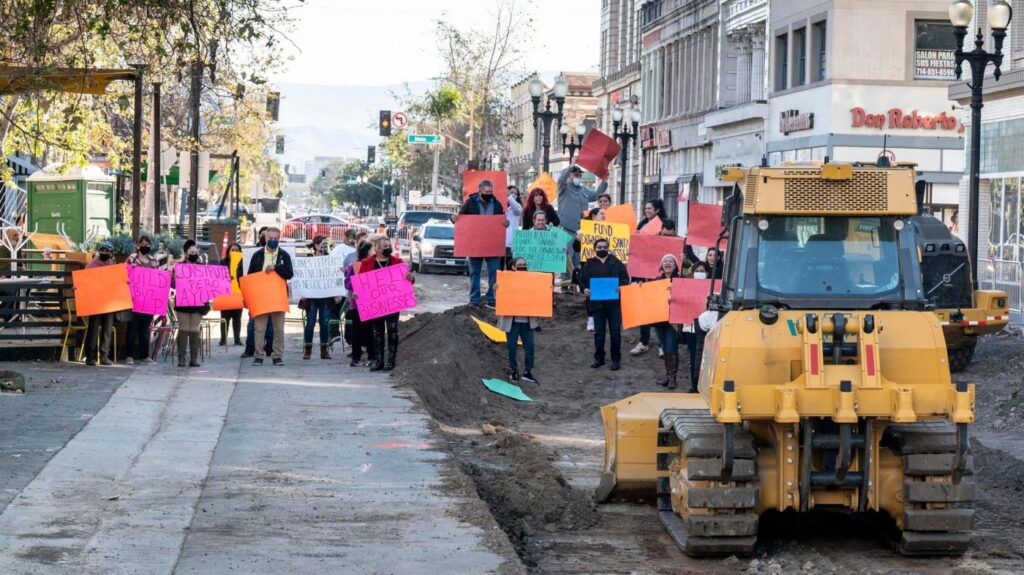
On a normal day, the 80 small businesses on Fourth Street in downtown Santa Ana bustle with diners and shoppers.
But on Wednesday the bustle wasn’t happening.
“It looks like a ghost town now,” said business owner Ana Laura Padilla.
Last week, Padilla and other merchants learned — without warning, they say — that the historic thoroughfare where they make their living will be closed for construction at least through the end of summer.
It’s Fourth Street’s turn to undergo installation of railway for the OC Streetcar, which will run 4.1 miles from Santa Ana to Garden Grove.
Dozens of business owners held a protest Wednesday, Feb. 9, demanding financial assistance and other kinds of relief from the Orange County Transportation Authority (OCTA) and the City of Santa Ana. The business owners claim both entities have offered anemic responses to their recent calls and emails
Standing in the middle of a newly dug trench, the demonstrators managed to shut down construction all morning.
Orange County Supervisor Katrina Foley, who sits on the OCTA board, joined them at 6 a.m.
Apparently, their efforts got the attention they’d been looking for. By Wednesday afternoon, city and OCTA officials gathered for a walking tour of the affected businesses.
Padilla, who organized the event, said construction dust and noise deter customers from coming to her restaurant, Perla Mexican Cuisine.
She also owns a tax preparation business, Themis Multiservices. She said that business, too, has seen a big drop in clients, largely because parking has become difficult and confusing.
“Imagine loud machines in the background while I’m trying to talk to a client about taxes,” Padilla said. “It’s a nightmare.”
Padilla and her neighbors are asking for better signage to advertise that their businesses remain open.They also want the city to pause parking fees at nearby structures, as well as economic aid to supplement decreased sales and fund additional cleaning services.
Delilah Snell, owner of Alta Baja Market and cafe, said her business was off 70% Friday and 30% over the weekend. The shop offers specialty products including a large selection of Mexican wines.
“My whole place smells like tar, which isn’t very appetizing,” Snell said. “And, because of COVID, we keep the doors and windows open.”
Snell said that OCTA in 2020 did some minor construction on the street for a couple of weeks to start laying the groundwork for railway.
“I knew they’d be back, but I assumed the next wave would be like the first,” Snell said. “I didn’t realize the whole street would get torn up.
“Already, because of the pandemic, some businesses on Fourth Street were just barely hanging on,” she added.
Unlike most of the other impacted streets, Fourth Street – one of the oldest business centers in Orange County – has only two lanes. And Santa Ana Councilman David Penaloza noted “the other boulevards are wide enough to leave half of the lanes open.”
Penaloza said that OCTA did not communicate with the business owners aggressively enough before closing Fourth Street.
“We’ve known for three years it was going to happen, eventually. But I think the resentment comes from the fact that there was no immediate warning of what the exact dates would be,” Penaloza said. “All of a sudden, (construction) was at the merchants’ front door.”
But OCTA spokesman Eric Carpenter said the agency consistently has kept Santa Ana merchants informed about the streetcar’s construction schedule.
“In early January, OCTA walked to (Fourth Street) businesses and handed fliers to alert them to the work,” Carpenter wrote in an email. “The last week of January, we also walked the community to alert them that work would begin the following week. We have been notifying businesses that this work would be coming since we began construction (in 2019).”
Foley concurred that the agency “has done a lot of outreach.”
“I’m not sure whether enough notice is the issue,” she said. “The issue is: What are we going to do to help these businesses now that their street has literally been shut down?”
Santa Ana Mayor Vicente Sarmiento said the city “wants to listen to viable, reasonable suggestions.”
“I don’t think there’s a silver bullet,” Sarmiento said. “But there are ways to make the situation more tolerable.” For instance, he said, OCTA could consider double crews working 16 hours a day to get the job done in half the time.
Whether free parking or reduced business license fees, Penaloza said the city should not pick up the entire tab.
“OCTA needs to reimburse us,” he said. “This is a county-led project. I would hope the city doesn’t bear all the cost of alleviating the hardships.”
The Santa Ana City Council approved the OC Streetcar route in 2014, saying the train will boost economic development. Merchants were split over whether the street car belonged on Fourth Street.
Originally scheduled for completion this year, the project hit some snags – including the discovery of contaminated soil and unmarked utilities – that have increased the price and pushed the anticipated opening to 2024. The budgeted cost of the streetcar project is now $509 million.
“I’m not sure it’s worth the price tag,” Penaloza said.
However, Foley said that once the dust clears, the streetcar will bring renewed vitality to business communities in Santa Ana and Garden Grove.
“It will help move people about while reducing our carbon footprint,” Foley said. “This is a project for the future, not a project for today.”
